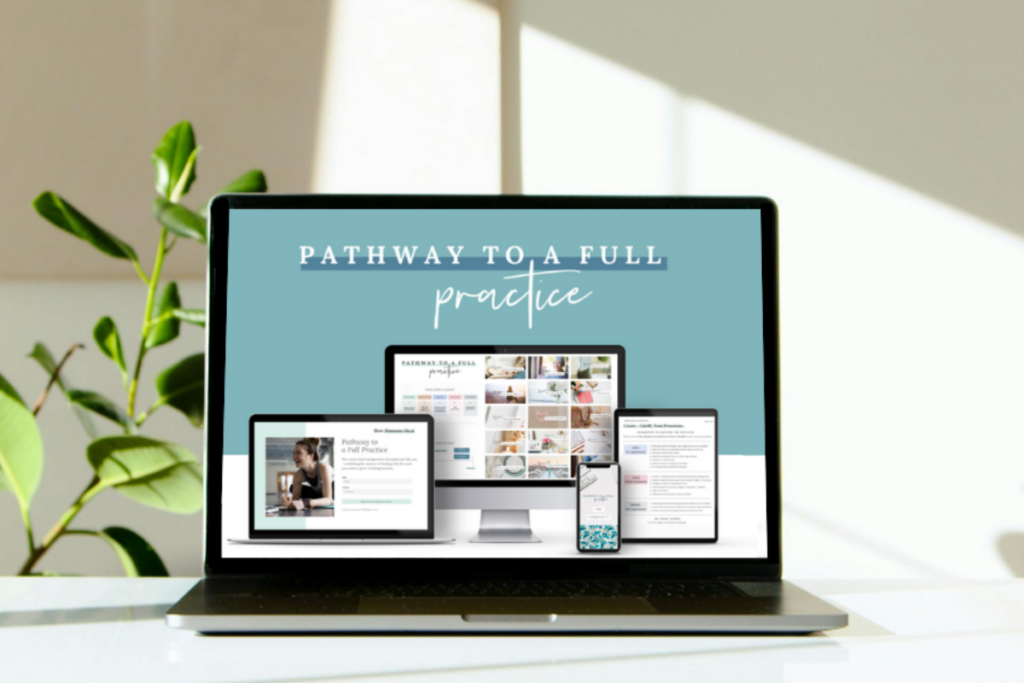You Don’t Have to Use Social Media to Grow a Thriving Practice
Sound radical? I can see why, in a world where having an online presence feels like a non-negotiable. But stay with me.
When I first started out, social media for therapists wasn’t really a thing yet. There were no Reels to make, no captions to agonise over. Fast-forward to now, and it can feel like being a therapist also means being a content creator, video editor, and full-time digital brand. Maybe you’ve felt that pressure to be visible, interesting and entertaining all while staying professional? If so, you’re not alone. So many thoughtful, skilled practitioners I meet feel drained and disheartened by this.

Looking back, I feel incredibly lucky that I learned to build my practice ‘the old-fashioned way’. AKA steadily, through a combination of being known for exactly how I helped people, along with the ripple effect of professional referrals and word-of-mouth recommendations.
The more time passes and the more frantic the pace and format of social media gets, the more I believe what we call old-fashioned is actually just a natural rhythm of real growth. A more sustainable kind of growth than the short bursts of one-off, maybe discounted bookings from marketing pushes you have to keep doing over and over again.
Social media can lend itself to this rollercoastery cycle of highs and lows, meaning that you see a flurry of bookings followed by silence, instead of a steady path to a consistently full appointment calendar.
And it has other downsides, too.
Remembering What Social Media Was Meant To Be
Social media started as a tool for connection. A way to share, communicate, and keep in touch. But – especially in the last 5 years or so – things have changed.
There was a time when posting something meant most of your followers would actually see it. That’s no longer how it works. These days, your feed is more likely to show you ads, influencers and content you didn’t ask for.
As a result, most of the therapists I know who do get strong results from social media are investing a lot behind the scenes – because they have to. It requires a whole lot of strategising around algorithms, hashtags, captions, trending audio and best posting times to translate your efforts into being seen by the people you want to reach.
Meanwhile, as these platforms have become more monetised, they’ve been designed to keep us scrolling and comparing (not necessarily connecting), feeding an underlying, unsettled feeling that you’re always ‘on’ and never quite enough.
The problem is, all of this has become so normal that we forget to question it.
A Gentle Rebellion: Reclaiming Connection
Some of the sharpest minds in psychology and culture have been sounding the alarm for a while now. Books like Jonathan Haidt’s The Anxious Generation and Johann Hari’s Stolen Focus have laid out the harms clearly: fractured attention, rising anxiety, and a culture that’s pulling us further away from ourselves and what matters. It’s no wonder that a growing number of people are stepping back for the sake of their mental health and echoing what author Elizabeth Gilbert said:
“It’s not good for my nervous system. It’s not how I want to spend my time. I want to live my life, not perform it.”
– ELIZABETH GILBERT
A recent survey found that 78% of people are actively trying to reduce their social media usage, seeking more ways to connect and engage offline. There seems to be a collective need for movement away from the noise and the hustle and toward something slower, more grounded, more present.

What Does This Mean for You as a Therapist?
But what if you’re someone who enjoys having an active social media presence? Connecting in the comments, designing posts in Canva, sharing what you love, engaging with clients and celebrating your work and your mission. I want to recognise and honour that, too. It’s totally possible to build real community online, and social media can be a positive tool.
So, this isn’t a call to quit all your social platforms! It’s an invitation to step back and really think about how social media is working for your business and your peace of mind.
Consider questions like these:
“Is the time and energy you put into social media actually helping your practice to grow?”
→ Is the engagement (follows, likes, shares) bringing you results beyond the likes themselves?
→ What percentage of new clients are finding you through your social channels?
→ If you’re not sure, how can you measure the impact of your social media time more directly?
And then ask yourself: “Is social media taking a toll on your energy, focus, self-esteem or sense of peace?”
→ Do you feel pressure to check for comments or DMs at all hours?
→ Do you spend more time than you realise thinking about what to post next?
→ Are you regularly comparing yourself to other practitioners and feeling like you don’t measure up?
→ Are you struggling to separate your personal and professional life because it’s all on the same little device in your pocket?
Whatever your answer to the question “Is this working for me?”, I hope this post can open up new conversations and possibilities. If you decide you want to shift some of your focus away from social media, I’d like you to know that there are other ways to foster genuine connections.
So How Do You Grow Without Social Media?
Here are a few ways to build your practice that don’t require being online all the time:
- Referrals from current or past clients – People love to recommend services that have made a difference in their lives. Make asking for referrals a natural part of your practice, whether it’s midway through a course of treatments, when someone is starting to experience the benefits of your approach, or at a final session. A simple, genuine prompt can go a long way: “If you know anyone who might benefit from this kind of support, please feel free to pass on my details.“
- Professional partnerships – Many GPs, doulas, physios, yoga teachers and other practitioners are already working with your future clients, and they can become strong allies. Nurturing relationships with other practitioners isn’t just about referrals — it’s about becoming part of a wider web of care.

- Community talks or workshops – You don’t need a big stage. A small circle in a library room or a quiet workshop at a yoga studio can create a relaxed, informal setting. Offer practical information that addresses the real needs you see, or the problems you know your clients have, such as anxiety, perimenopause, nervous system regulation. Show up as yourself.
- Start a Newsletter – A calm way to invite your past, current, and future clients to learn more about what you offer. Newsletters are like tending a small, steady fire. You’re writing to connect, quietly and consistently. You don’t have to worry about whether an algorithm will make you visible or not, because you’ve been invited into someone’s inbox. Share a bit about you, the practitioner, plus helpful information. Let people read you in their own time.

- Well-timed articles or blog posts – You don’t need to write every week. One or two strong, thoughtful pieces, especially if they tap into something that’s having ‘a moment’ in public awareness (such as menopause, neurodiversity, or mental health) can keep drawing new visitors to your website over months and years.
Growing your practice doesn’t just happen ‘out in the world,’ where people hear about you or meet you. The way you structure your offers and design your clients’ journey through your services also plays a big role in why people seek you out as a therapist. For example:
- A Signature Programme – A programme or package that brings all your skills and expertise together in a distinctive way, and that captures your unique approach to the issues you work with. This gives people an easy way to talk about you: “Oh, you should see [Your Name], she has this amazing approach to [specific issue].”
- Thoughtful systems behind-the-scenes – Be known for how you hold people. From the moment they enquire to their final session, your client journey should be clear, warm and professional. Small touches like prompt replies, welcome emails, thoughtful reminders, and simple resources are the things people tell their friends about.
I hope these ideas have shown just how many meaningful, effective ways there are to connect with the people you’re here to help. Whether or not social media is part of your plan, any of these approaches can play a key role in how you grow your practice.
You Have A Choice
Social media for therapists is optional.
While it’s come to play a big role in how we communicate, it’s not the only path, and it certainly doesn’t have to dominate your practice-building plans. You can choose to use it with intention, as a helpful tool, without letting it take over your time, energy, or self-worth, or to not use it at all.
What matters most is finding a way of working that brings the results you want, feels true to who you are, and is sustainable in the long run.
I’d love to hear…how are you thinking about your relationship with social media these days?
Looking For A Different Way?

If you enjoyed this blog post, and you’re looking for a different way to build your practice, you might be interested in Pathway to a Full Practice—my online programme for holistic therapists. You’ll learn how to build a sustainable, values-led practice that grows steadily, with or without social media. Find out more and join the waitlist here.

+ show Comments
- Hide Comments
add a comment